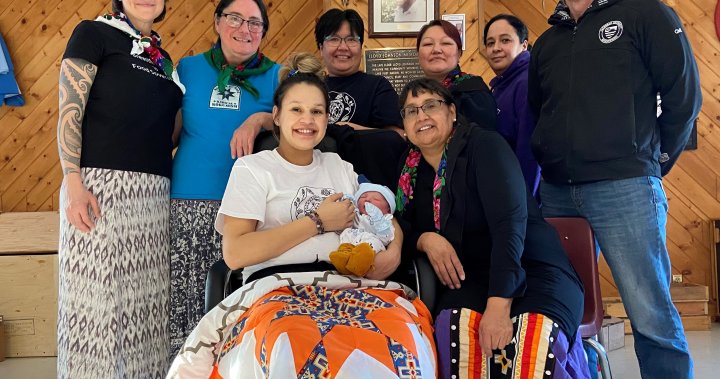A Traditional Birth in Sturgeon Lake First Nation Celebrates Indigenous Healing and Challenges Evacuation Practices
In Sturgeon Lake First Nation, Sask., a fire was lit in the healing lodge as Ashley Rabbitskin prepared to give birth to her baby boy. Surrounded by her family and a team of midwives, Ashley underwent a smudging ceremony to cleanse the space and received support and guidance using traditional medicines throughout her labor. As her son, Kaleo, entered the world, both the midwives and Ashley’s family joined together in song to celebrate his arrival.
This traditional birth is a significant step towards implementing Call to Action 22 of the Truth and Reconciliation Commission of Canada, which calls for the recognition of the value of Indigenous healing practices. The community is currently working on building a birthing center to restore the tradition of community-based childbirth, which has been denied to Indigenous people for decades.
In remote Indigenous communities across Canada, many pregnant women with low-risk pregnancies are forced to give birth far away from their families, culture, and language due to the lack of birthing facilities and healthcare professionals. Known as “birth evacuation,” this practice aims to reduce infant mortality rates but often comes with emotional and personal costs.
Indigenous midwives, such as Diane Simon, a Mi’kmaw midwife, believe that giving birth in the community provides emotional, cultural, and spiritual support crucial for the well-being of Indigenous women. However, the ongoing physician shortage and rural hospital closures in Canada make it increasingly challenging for Indigenous women to access local care during pregnancy, resulting in longer travel distances.
Alisha Julien Reid, a Mi’kmaw midwife and co-chair of the National Council of Indigenous Midwives (NCIM), strongly condemns the routine and blanket evacuation of pregnant Indigenous individuals and demands the return of birthing services to all Indigenous communities. Evacuation not only separates women from their support networks and familiar environments but also places them in transitional housing shelters or motels, increasing their vulnerability.
The isolation experienced by mothers giving birth away from their communities became evident during the COVID-19 pandemic. Indigenous people have long faced similar circumstances due to travel restrictions and limited access to support networks during births.
One way to reintroduce traditional birth practices is through the expertise of midwives. Indigenous midwifery programs, though limited in number, exist throughout Canada. These programs embrace holistic care, addressing not only the physical aspects of childbirth but also the emotional, cultural, and spiritual well-being of expectant mothers. However, access to midwives remains limited in most First Nations communities, forcing women to give birth away from their homes.
Ashley Rabbitskin’s traditional birth in Sturgeon Lake First Nation stands as a powerful example of reclaiming Indigenous birthing practices and challenging the evacuation system. Through the establishment of birthing centers and increased access to midwives, Indigenous communities strive to restore their cultural traditions and empower women to give birth in their own communities.
Denial of responsibility! Vigour Times is an automatic aggregator of Global media. In each content, the hyperlink to the primary source is specified. All trademarks belong to their rightful owners, and all materials to their authors. For any complaint, please reach us at – [email protected]. We will take necessary action within 24 hours.


